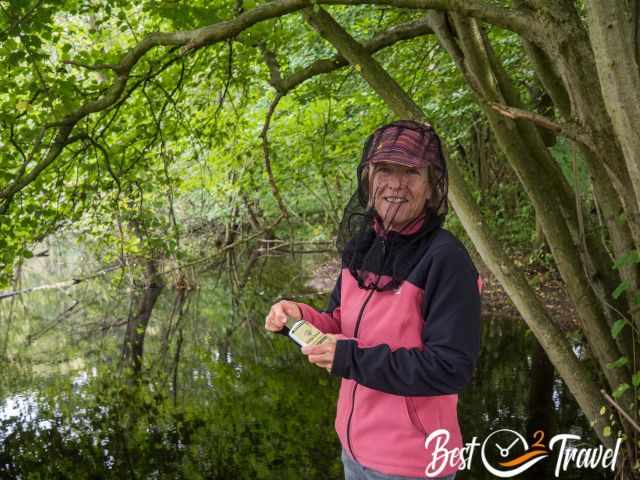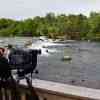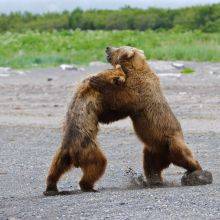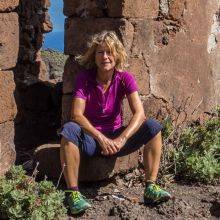When Is the Best Time
Katmai, located in Alaska, is an exceptional place to watch grizzlies close, sometimes even too close. Katmai is the bear country, so it does not come as a surprise that my friend Chris took the same path as a bear with his catch and had a close encounter. This is not an exception; be prepared that this can always happen. Most importantly, do not run away; give the bear space, and remain calm. The first thing you get after your arrival is an introduction on how to behave in the "Bear Country".
More than 2,000 bears call the National Park their home. Brown bears are in the area from mid-spring until October because of the massive sockeye salmon run - the biggest occurrence in the world. Usually, the salmon run takes place from the mid-latest end of June until the end of July, but it can also be in August. The salmon run is not predictable. The sockeye salmon from the sea swim and jump upstream to spawn where they were born before dying. This is a spectacular event annually.
The best times to spot the highest concentration of brown bears catching red salmon at Brooks River and Falls are July and September, followed by June and August.
You may spot 20 to 50 bears during the salmon run session along the falls. Usually, less food is available in June and August at Brooks River. Nevertheless, you may always spot bears, just fewer. The bears wander around where most food is provided by nature. The largest and most dominant bears have the "right" to be around Brooks Falls.
In 2023, the salmon arrived two weeks later, but the bears were able to gain enough weight for the next winter.
In 2022, the salmon arrived earlier, which was excellent for the bears and a big feast.
In 2021, the salmon returned later for spawning than usual, which caused stress for the bears who depend on high-energy food. Many bears did not catch as many fish as they usually do at this time of the year. Bears were more aggressive, with more fights where they tolerated each other. Also, a higher number of visitors stressed the bears.
Please, if you visit Katmai, you need extra caution as bears may be less tolerant. There were already human-bear contacts, which are also unusual and have not been documented in the last years. These bears live in the wild and behave accordingly. Remain 50 yards away from bears all the time. Give way to the bears when they want to access the river and falls. The park rangers will give you advice.
Annual Fat Bear Week Contest
Fat Bear Week voting from October 2 to 8 in 2024. This year, unfortunately, without the famous super bear Otis. He didn't show up to the falls.
On the 10th of October, 2023, the next champion was announced. Who was the winner of the 12 candidates? The champion is 128 Grazer, a female brown bear well prepared for winter.
In 2022, it was a better year regarding the salmon run; it was earlier than usual, from late June until mid-September. However, the salmon appear in waves before they run consistently up the river.
Who was the fattest brown bear in 2022? The massive winner from Brooks Falls was 747 with the nickname Jumbo Jet, and it is the second title in three years. You wouldn't believe how heavy he was, estimated at 1400 pounds. It was hard work fishing salmon daily for almost three months. Due to his size, he is at the top of the hierarchy at Brooks Falls. The second one is a female, which was given the name 901.
The Annual Katmai Brooks Falls Lodge Lottery Opens on 12/1/2023 for 2025 - always two years in advance.
Are There Bugs in Katmai?

Katmai is all about bears, salmon, and fishing, but Alaska experiences lots of rain and bugs, not only mosquitoes. That's the price you have to pay for this unique annual salmon run. Come prepared and carry these essentials in your bag:
Crowds at Brooks Falls
In July, expect crowded conditions at the viewing platforms. There is a limit of 40 people watching the bears for a maximum of one hour controlled by rangers, but if it is utterly busy, the time is limited to half an hour. September is much better with fewer tourists. Time of day suggestion: Stay overnight at the lodge or the campground. Then you can get to the platforms between 5 and 10 p.m. when the day visitors have already left, taking the plane back to Anchorage or another lodge. At that time of the day, the viewing platform is less crowded. Livecam: Brooks Falls Bears Livecam
Did you know that millions of viewers watch and follow the Katmai bears since 2012? In 2023 roughly 16 million viewers watched the bear cams.
Tip: Especially in July, you may wait two hours to access the platform for just half an hour of watching time. I recommend checking out the Riffles platform in the meantime.
Opening Hours Visitor Platforms
The Falls and Riffles Platform are open from 7 am until 10 pm. When day visitors have left Brooks Falls, it is quieter here.
Photographer Tips for Katmai
Consider the best zoom camera lens if you wish to take excellent shots. At least a 200-400 mm zoom lens is recommended, but it is better at 600 mm. There are not always plenty of bears at Brooks Falls; instead, they are further away. Tripods are not allowed in July, making it tricky with a 600 mm lens.
- Distance Falls platform to middle Brooks Falls, approx.140 feet
- Distance Falls platform to the far side of the Falls, approx. 280 feet
- Distance from the Riffles platform to Brooks Falls, approx. 400 feet
The Best Daytime at Katmai
The best daytime at the platform is mid to late afternoon, July after 4 pm on the rare occasion the sun is out, giving a special note.
Weather Katmai - Alaska

In late spring, summer and early fall, it's often rainy and overcast. Especially in the summer months, the weather is unpredictable. Summer temperatures range from 30˚ to 80˚ Fahrenheit (-1˚ to 27˚ Celsius), so everything is possible. Only 20% of the days are clear and sunny in summer; the downside bugs are even worse. Winters are drier and very cold.
Monthly Bear Activity Overview
- April to Early May (higher slopes) - Emerging from their hibernation and bear fighting.
- Mid-May to mid-July - Mother and Cubs and mating season
- End of June and July - Salmon Run - Bears gather around the falls. The grizzlies feed mainly on the nutrient-rich brain and eggs of the salmon. The leftovers are for other animals and fertilize the land. They are a key species for the entire ecosystem of the Katmai National Park. Bears are more aggressive.
- In August, are often fewer bears because the salmon have already passed Brooks Falls and reached the breeding grounds where they were born, but not in 2022.
- September is a feast for the bears again. The salmon dies after spawning/breeding and floating down the Brooks River. Now, the bears feed even more on the salmon. Bears are less aggressive.
- Mid-September to mid-October - Bears Resting.
- Before November, bears are digging a den for hibernation.
- November until March - Bears hibernate because of the harsh winter conditions.
- Up to four cubs are born in mid-winter from January to February.
Visitor Center
The Visitor Centre is open, and a Ranger is available at Brooks Camp from June to mid-September. Another Visitor Center can be found at King Salmon Airport. You get a brief bear safety talk after arrival in Brooks.
How to Get to Brooks Falls?
It is a little tricky to get here. Brooks Falls is situated in the remote wilderness. There are two options to get to Brooks Falls, but both are weather-depending, and the weather is unpredictable. From King Salmon, you have to change into a floatplane or a water taxi to get to Brooks Falls, which takes 20 minutes to one hour, depending on what you choose.
- The nearest airport is King Salmon (AKN); commercial flights are offered. If fog occurs, flights are delayed or cancelled. However, the view from the float plane is spectacular, and the right is much faster around 20 minutes. The float plane is more expensive, but fewer cancellations occur. The float planes land on Lake Naknek but can land on Lake Brooks instead if the waves are too high and you are picked up by a bus.
- The second option is the water taxi, which may get cancelled if it is too windy because they only get to Brooks Falls on the river to Lake Naknek. The water taxi to Brooks Falls takes much longer, roughly one hour.
Where to Stay at Brooks Falls?
There are two places to stay in Brooks Falls.
- The Brooks Falls Lodge and the campground. The lodge is a little pricey. The campground is around $9 per night but will already be fully booked by the end of January.
- Another hassle-free opportunity is Alaska's Gold Creek Lodge, next to the airport. They pick you up and offer day trips to Brooks Falls. However, you miss the best time for perfect shots in the evening.
Due to the limited availability, some stay at King Salmon and enjoy the other wildlife here. Keep in mind the annoying bugs, and bring insect repellent!
 |
Do NOT go without this map. It was created in cooperation with the National Park Service and others. This expertly researched map covers the entirety of Katmai National Park and Wilderness and neighbouring areas with many details. |
Best Months to Visit
Location and Tips

Katmai has one of the highest densities of bears in the world, estimated at 2.200. The food search determines their life. Due to the long hibernation, they need to gain much weight to survive. So the question is where to see these majestic creatures. They are spread over the entire Katmai National Park.
The park was once protected for the volcanic devasted area in 1918, Katmai is nowadays most famous for brown bears and fishing. The bears are at Brooks Falls and along the entire Brooks River.
There are two more viewing platforms, one before and one after the falls. These outlooks are less crowded. It is relatively safe around Brooks Falls; however, it is their wild habitat. There is no guarantee! Safety first, always!
If you like to watch bears hunting for sockeye salmon at a waterfall, this is the best place of all. Getting to McNeill Falls is more complicated, and a permit is necessary.
Safety Advice for the Viewing Platforms - Wheelchair Accessibility
The viewing platforms are wheelchair accessible, especially the north and south at the river mouth close to the lodge. Shortly before the falls, the Brooks Falls and Riffles are not paved and, therefore, a bit muddy in poor weather conditions. There is one platform at the falls, one shortly before the falls and three at the mouth of Brooks River. The platforms are closed and not accessible for safety reasons from 10 p.m. to 7 a.m. Walking to Brooks Falls platforms is more than one mile - two km. Walking Map from Brooks Falls Lodge to Riffles and Falls Platform Locus Map
- Stay on the trail to the viewing platform
- Remain quiet
- No use of a flashlight
- Don't leave any trash
- Please, don't smoke.
- Only pure water is allowed to drink
Is Bear Spray in Katmai Necessary?
This is often discussed, and most people say no. However, if you need bear spray to feel safer, you usually get it for free when other people leave it in one of the "free boxes"; one is at the campground in the gear cache, and the other in the storage cache next to the Visitor Centre. If none are available, you can purchase bear spray in the small store at Brooks Lodge. I have to confess when we travelled through "bear land", we carried bear spray just in case.
The Salmon Migration
It is the salmon life circle. The salmon born in the upper river in freshwater migrate to the ocean when reaching maturity after one to two years. It is a long process adapted to freshwater first and then saltwater. They live and feed for years in the ocean before turning back for reproducing and spawning. When the urge to migrate back appears, they stop feeding, relying on their energy and fat. It is a demanding migration to get back to the spawning grounds. In the beginning, they appear in waves at the peak constantly. Depending on the salmon species, they are between one and six years old. The released salmon eggs hatch in mid-winter.
A great alternative for watching the bears in their natural environment without crowds is Hallo Bay in Katmai.
The History of Katmai National Park
One of the most significant volcanic eruptions happened in 1912 on the Alaskan Peninsula, and Mount Katmai collapsed, forming a 2000-foot-deep caldera. There was 30 times more magma released than at the St. Helens eruption in 1980; caused by the outbreak, the amazing "Valley of Ten Thousand Smokes" was created. In 1918, it became a National Monument to protect the entire area. It is still an active volcanic park, remembering the power of Mother Nature. Katmai became a National Park status in 1980. A park ranger-led bus ride and hike to the Valley of Ten Thousand Smokes is offered. The tour starts at Brooks Lodge.
These breathtaking Alaska Bear pictures are provided by my friend and photographer Chris. If you wish to use any, contact me, but we will take action against picture theft!













































































